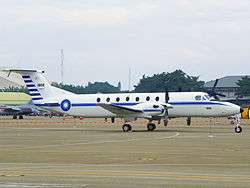ACE Air Cargo Flight 51
 Beechcraft 1900C-1 similar to the one involved in the crash | |
| Accident | |
|---|---|
| Date | 8 March 2013 |
| Summary | Pilot error (controlled flight into terrain) |
| Site | Muklung Hills |
| Aircraft | |
| Aircraft type | Beechcraft 1900C-1 |
| Operator | ACE Air Cargo |
| ICAO flight No. | AER51 |
| Call sign | ACE AIR 51 |
| Registration | N116AX |
| Flight origin |
King Salmon Airport King Salmon, Alaska |
| Destination |
Dillingham Municipal Airport Dillingham, Alaska |
| Passengers | 0 |
| Crew | 2 |
| Fatalities | 2 |
| Survivors | 0 |
ACE Air Cargo Flight 51 was an Alaska Central Express flight from Anchorage to King Salmon and Dillingham, Alaska. On 8 March 2013, the Beechcraft 1900C-1 serving the flight, registration N116AX, crashed into a mountain on approach to Dillingham Municipal Airport, killing both crew members operating the flight.
Involved
Aircraft
The aircraft, a Beechcraft 1900C-1, serial number UC-17 registered N116AX, was manufactured in 1992, and ACE Air Cargo was its only operator, accumulating a total of 29,824 hours before the accident. The aircraft was powered by two Pratt & Whitney Canada PT6A-65B engines and was equipped for flight into icy conditions, but did not carry a cockpit voice recorder or flight data recorder.[1][2][3]
Crew
The crew on this flight consisted of only the cockpit crew, 38-year-old Captain Jeff Day and 21-year-old First Officer Neil Jensen with 5,770 flight hours and 470 flight hours, respectively.[2][4]
Flight
The flight had originally taken off from Anchorage International Airport at approximately 5:44 Alaska Standard Time, making a scheduled stop at King Salmon and continuing to Dillingham. En route to Dillingham, the crew requested a RNAV GPS 19 instrument approach, which was granted by the on-duty controller who directed the crew to maintain an altitude at or above 2,000 ft (610 m). Roughly six minutes later, the crew requested permission to enter into a holding pattern to contact the flight service station for a report on the condition of the runway, which was subsequently granted. The controllers later attempted to contact the aircraft, but were unsuccessful and soon lost radar track of the aircraft, which had crashed at Muklung Hills.[2][3]
Investigation
Search and rescue operation
The aircraft hit the ground in a mountainous area called the Muklung Hills. This was the same area where, in 2010, an aircraft carrying nine people crashed; the passengers included former US Senator Ted Stevens, who was one of the five killed, and former NASA administrator Sean O'Keefe, who was one of the four survivors.[5][6][7] The rescue operation to reach Flight 51 was carried out by the Alaska Air National Guard, Alaska State Troopers, and United States Coast Guard. The first rescue unit to reach the crash site was an Alaska Air National Guard helicopter, which was unable to land or lower rescuers due to poor weather conditions.[4][7]
Examination and investigation
The accident was investigated by the National Transportation Safety Board (NTSB) who concluded that the plane crashed due to the flight crew's failure to maintain terrain clearance, which resulted in controlled flight into terrain in instrument meteorological conditions.[8]
References
- ↑ "Ace Air Cargo flight 51 , crashed while approaching airport". Airplanes24.net. Archived from the original on April 5, 2016. Retrieved March 19, 2016.
- 1 2 3 "ANC13FA030: Full Narrative". National Transportation Safety Board. Retrieved March 15, 2016.
- 1 2 "Aircraft accident Beechcraft 1900C-1 N116AX Dillingham Municipal Airport, AK (DLG)". Air Safety Network. Retrieved March 15, 2016.
- 1 2 Grove, Casey (March 9, 2013). "Bodies of pilot, copilot pulled from wreckage northeast of Dillingham". Alaska Dispatch News. Retrieved March 23, 2016.
- ↑ "Former Sen. Ted Stevens dies in plane crash". NBC News. August 10, 2010. Retrieved March 24, 2016.
- ↑ Winter, Michael (August 10, 2010). "Ex-NASA chief O'Keefe survives Alaska crash that killed Ted Stevens". USA Today. Retrieved March 24, 2016.
- 1 2 Grove, Casey (March 8, 2013). "Snowfall hampers search for cargo plane down in Southwest Alaska". Alaska Dispatch News. Retrieved March 24, 2016.
- ↑ The flight crew's failure to maintain terrain clearance, which resulted in controlled flight into terrain in instrument meteorological conditions.